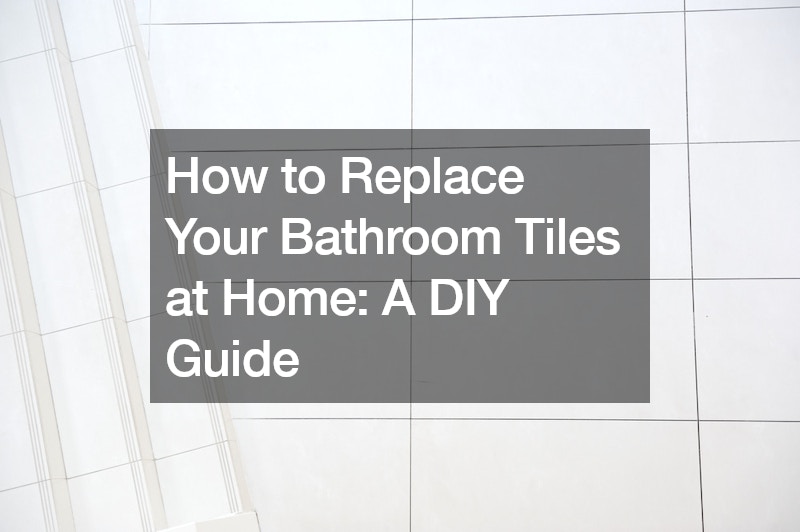
Updating your bathroom can breathe new life into your home, and one of the most impactful changes you can make is replacing old tiles with modern, large format tiles. Not only do these tiles look great, but they also make a small bathroom feel more spacious. In this guide, we’ll walk you through the steps to replace your bathroom tiles at home. Whether you’re a seasoned DIYer or a beginner, you can achieve professional-looking results by following these tips.
Getting Started
Before you begin, you’ll need to gather your materials. For this project, you will need large format tiles, a tile cutter or angle grinder, a notched trowel, modified and unmodified mortar, a grout float, grout, a sponge, a bucket, a rigid mixer, and safety gear such as gloves and goggles.
Step 1: Remove the Old Tiles
The first step in tile installation is removing the old tiles. Using a large demo bar, pry up the old tiles from the floor. If they were not installed correctly, this part might be easier than expected. However, be prepared for some hard work if the tiles are firmly attached. You may need a hammer drill with a scraping blade to remove the old adhesive from the subfloor.
Step 2: Prepare the Subfloor
Once the old tiles are removed, it’s crucial to prepare the subfloor. A flat and clean subfloor is essential for a successful tile installation. If your subfloor is made of OSB (Oriented Strand Board), use a belt sander to smooth out any raised seams. Next, install an underlayment like Schluter Ditra, which acts as both an uncoupling membrane and a waterproofer. Cut the Ditra to fit your floor, leaving a quarter-inch gap from the walls, and secure it with modified mortar using a notched trowel.
Step 3: Plan Your Tile Layout
Planning your tile layout before you start setting them in place is crucial. This step ensures you have a balanced and visually appealing design without small slivers of tiles at the edges. Use a computer program like SketchUp to layout the tiles virtually. Aim for a brick pattern with a third-tile overlap to minimize lippage, which occurs when tiles are not perfectly level with each other.
Step 4: Cut and Dry Fit the Tiles
Before applying mortar, dry fit the tiles to ensure your layout works in the actual space. Cut the tiles to size using a tile cutter or angle grinder. Make sure to wear safety goggles and a mask when cutting tiles to protect yourself from dust and debris. This step will help you make necessary adjustments before the mortar sets, ensuring a perfect fit.
Step 5: Apply Mortar and Set Tiles
Mix your unmodified mortar to a thick milkshake consistency using a rigid mixer. Apply the mortar to the Ditra underlayment with a half-inch by half-inch square notch trowel. Spread the mortar evenly, working it into the waffle pattern of the Ditra. Back butter each tile by spreading a thin layer of mortar on the back before setting it in place. This ensures a strong bond between the tile and the subfloor.
Use a leveling system like the Rigid LevelMax to keep the tiles aligned and flush. This system helps reduce lippage and ensures a professional-looking finish. Work your way across the floor, laying the tiles according to your planned layout. Press each tile firmly into the mortar, using spacers to maintain consistent grout lines.
Step 6: Grout the Tiles
After the mortar has set for at least 24 hours, it’s time to grout the tiles. Mix the grout according to the manufacturer’s instructions. Using a grout float, apply the grout at a 45-degree angle to the joints, pressing it into the spaces between the tiles. Wipe away excess grout with a damp sponge, being careful not to remove too much from the joints. Rinse the sponge frequently and wring it out well to avoid adding too much water to the grout, which can cause discoloration.
Step 7: Clean and Seal
Once the grout has dried, usually overnight, buff the tiles with a dry cloth to remove any grout haze. For tougher spots, use a haze remover. Apply a grout sealer to protect the grout from stains and moisture. This step is especially important in a bathroom where water exposure is frequent.
Final Touches
Reinstall any baseboards or trim, and apply grout-colored caulk around the edges where the tiles meet the walls or tub. This creates a clean, finished look and helps prevent water from seeping behind the tiles.
Conclusion
Replacing your bathroom tiles can be a rewarding DIY project that transforms your space. By following these steps, you can achieve a professional-looking tile installation and enjoy the fresh, updated look of your bathroom. Remember, preparation and planning are key to success, so take your time and don’t rush the process. Happy tiling!
.

